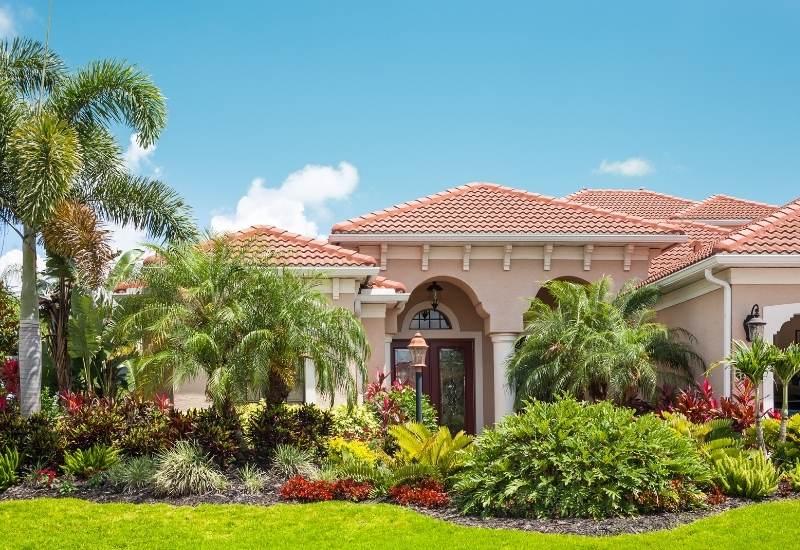
The first fact that you should know about palm trees is that they are not trees at all! Instead, the correct way to classify palm trees is as a woody perennial much like bamboo. All types of palm trees fall into the Aceraceae family.
But similarities in palm tree classification end there. Many of the most popular palms are not only different species from one another. They also come from different genera. That genetic diversity matches the diversity of physical characteristics that belong to different types of palm trees.
The most recognizable varieties are the tall palm trees that grow in places like Florida. But with over 2,600 species within the Aceraceae family, you can expect to find palm trees of many shapes and sizes.
Before you can decide your preferred palm tree species, it is helpful to understand some basic palm tree identification. After knowing how to identify palms in general, you can proceed to distinguishing the many distinct varieties.
How To Identify What Kind Of Palm Tree Do You Have?
Despite such variety among palm trees, there are some common characteristics you can look for when trying to identify palm tree species you have. The most obvious signs that you are looking at a palm tree are the physical attributes and the setting in which the plant grows.
Palm trees often have a single stalk that grows straight out of the ground. The leaves are often concentrated at the top part of the stalk, where the canopy often takes a rounded or spreading form. There are also several common varieties of leaves among palms. The two most common are fan-shaped leaves and feather-shaped leaves.
But regardless of the variety of leaf, the foliage of many palms is large in comparison to the rest of the plant. In some cases, a large palm tree will have leaves that are nearly 20 feet. Setting is another way to identify palms. These species of plants only grow naturally in specific climate regions.
Most often, palms will grow in desert areas or near the ocean. There are some palm varieties that also grow as understory plants in the rainforest.
In any of these typical settings, palms love hot weather. That is why those in northern regions will struggle to find palms that grow in their region other than as indoor plants.
When palms grow outdoors, they can take many forms. This is because there is a vast array of different palm species. Some of these species are smaller and somewhat broad.
Other species develop into the tall swaying palm trees many people know and love. Most palms are highly attractive so long as their settings contribute to their healthy growth. But beyond aesthetics, some species of palms are very useful as well.
Palm Tree Uses
Palm trees are often emblematic of tropical beach destinations. While this symbolism is accurate to the native range of many palm varieties, the uses of palm trees expand beyond visual appeal.Many palms bear large quantities of edible fruits.
The fruits are staples in many regions of the world, including the Middle East and the Caribbean.
Consumers don’t always recognize that the fruit there are purchasing came from a palm tree variety. Coconuts are one such example of a well-known fruit that many are shocked to find comes from a type of palm tree.
Palms provide a myriad of products other than fruit. These include palm oils that are useful in cooking as well as palm extract, which may have medicinal benefits. With all these additional benefits, palm trees remain highly attractive as well. Now it’s time to dive into the qualities that each palm species has to offer.
25 Palm Tree Varieties Of Indoors And Outdoors
This list of the best palm tree varieties includes three sections. The first covers palms for indoor use. Then we proceed to the palm varieties that grow in the wild. Lastly, we’ll look at some palms with edible fruits. Read on the see which palm variety is best for you.
Palm Varieties That Grow Indoors
Due to their preferred conditions, there are very few places where palms grow naturally in the United States. In fact, only those in the southernmost portions of the country can expect to grow them with consistent success outdoors.
However, the fact that palm trees typically prefer a hotter climate does not mean that those in colder regions cannot enjoy them.
While establishing palms outdoors in states north of Texas and Florida is rare, growing them as indoor plants is quite common.
In this section, you can find some palm tree varieties that are suitable as indoor plants. Some of these palms have a smaller mature size naturally.
Others may be dwarf varieties of species that are typically larger. Either way, here are a few of the best indoor palm tree species.
1. Phoenix Roebelenii (Dwarf Date Palm)
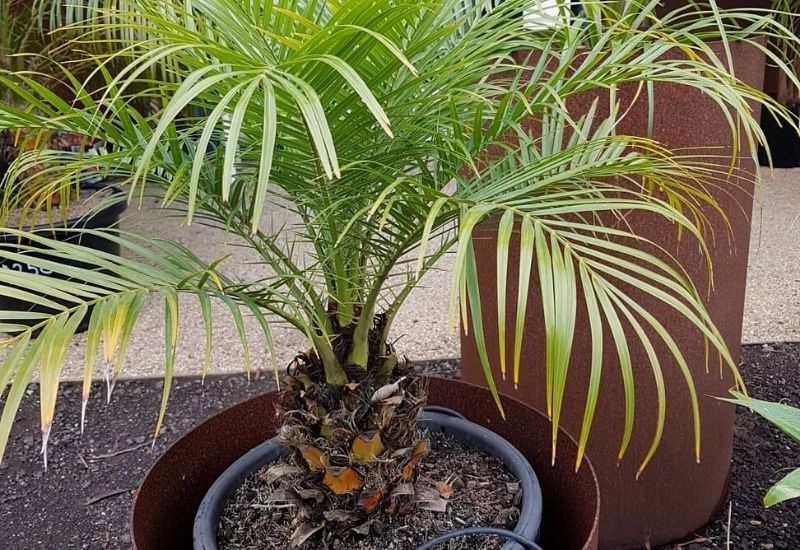
Dwarf date palm is a smaller variety of the much larger date palm. While a typical date palm will grow taller than your house, a dwarf date palm will fit inside.
This palm grows to a maximum height of 6 feet. That means it will fit easily in most indoor rooms. Just make sure to give this palm tree plenty of sunlight.
The thin leaves of dwarf date palm comprise the majority of this plant. At times, these leaves can be nearly 5 feet long.
Overall, the dwarf date palm is a slow-growing plant. So, while it can reach a height of 6 feet, it will take a while for that to happen.
2. Chamaedorea Elegans (Parlor Palm)
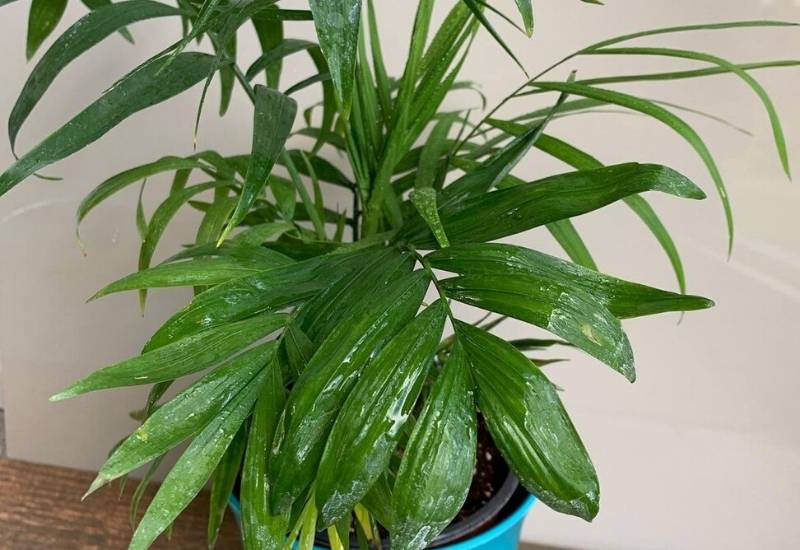
Parlor palm is a small palm tree variety that is native to the southern regions of Mexico. Interestingly, this palm can grow in the wild and as an indoor plant.
When growing in the wild, parlor palm is a part of the rainforest understory. In those settings, it reaches about 15 feet. When growing indoors, parlor palm will be less than half that height at maturity.
Parlor palm often develops multiple stalks that create a shrub-like appearance. The leaves that grow from the stalks are long and attractive, often representing most of the ornamental value of this plant.
Parlor palm also stands out as one of the few palm tree varieties that tolerate lower levels of light. This contributes to its use as an indoor plant.
3. Jubaea Chilensis (Chilean Wine Palm)
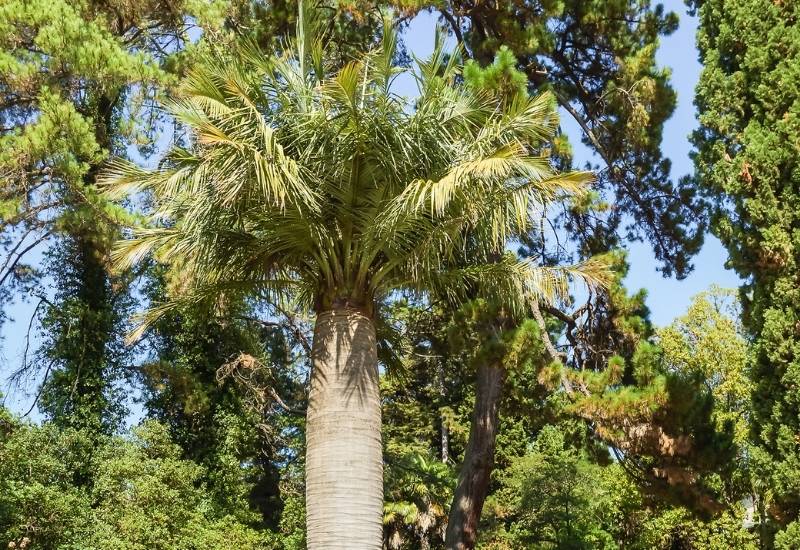
Chilean wine palm is a drought-tolerant plant that can grow in many settings. Not only does it have a broader range than most palms, extending as far north as zone 8. It also can grow as an indoor or outdoor plant.
This palm is a slow grower, but when given time and the right outdoor conditions, it can reach an impressive size. This includes a thick trunk and a broad canopy consisting of long feathery leaves.
Chilean wine palm also has a long lifespan and takes a while to develop fully. For example, it can take up to half a century for Chilean wine palm to offer its first set of blooms. But when these blooms arrive, they are vibrant in shades of yellow and purple.
Those planting this palm indoors will need to choose an ideal location. Most often, areas near a south-facing window are best to allow the Chilean wine palm to get the full sun exposure it needs for healthy growth.
4. Livistona Chinensis (Dwarf Chinese Fan Palm)
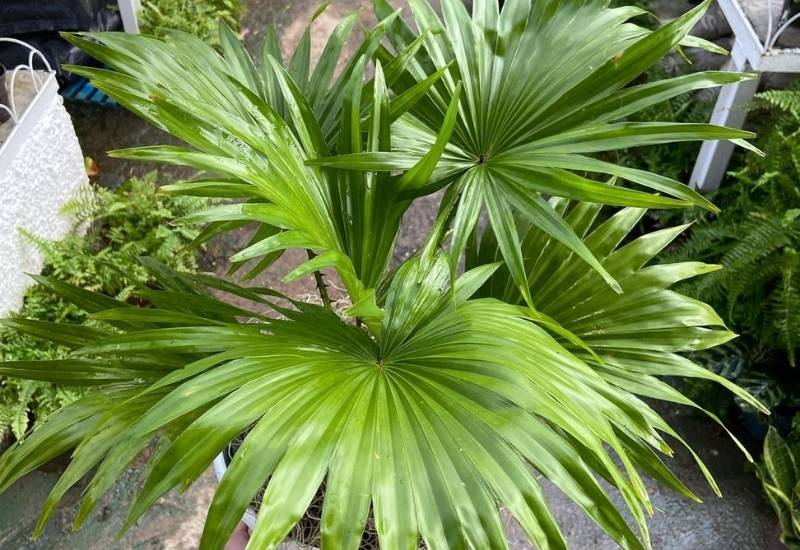
Dwarf Chinese fan palm is a cultivar of a species native to Asia. This palm has prominent leaves that are very wide. As the common name suggests, these evergreen leaves mimic the shape of a fan.
This dwarf palm reaches a maximum height of 7 feet when in a container. But, again, it takes many years for it to reach this height.
Like many palm trees, dwarf Chinese fan palm prefers a lot of sun for most of its life span. The only exception is during youth when this palm needs more shade.
There are two main reasons why it is best to keep this plant indoors. The first is that it only grows in warm climates. That means it won’t survive outdoors in many parts of the United States. The second is that dwarf Chinese palm is invasive in many states.
5. Chamaedorea Cataractarum (Cat Palm)
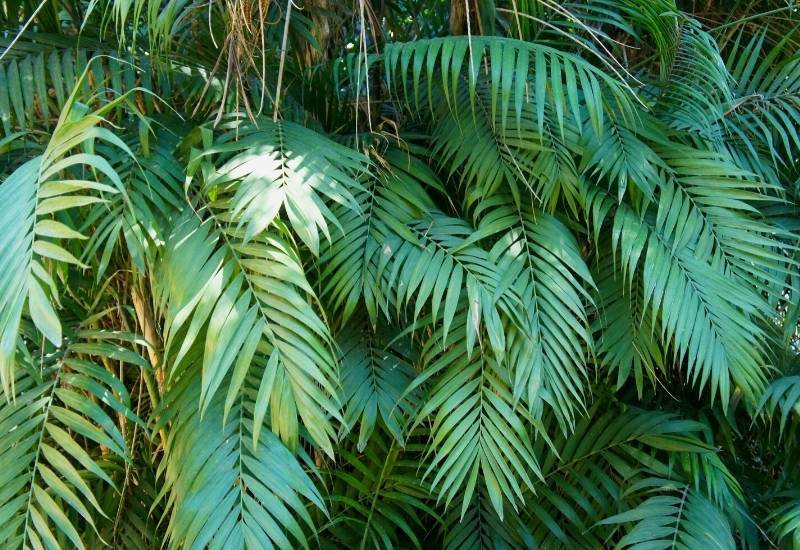
Cat palm has a growth habit that makes it different from most other indoor palms. The form of a cat palm includes multiple thin stems instead of one primary stem.
Each stem carries a set of elongated leaves that have rounded tips and a deep green color. These leaves tend to be numerous.
Unlike other indoor palm trees, cat palm requires a higher degree of maintenance. This includes maintaining a specific level of moisture in the soil.
To its benefit, cat palm is a smaller indoor tree that reaches only 3 feet. That small mature size makes it so that you can incorporate a cat palm even in areas of limited space.
6. Cycas Revoluta (Sago Palm)
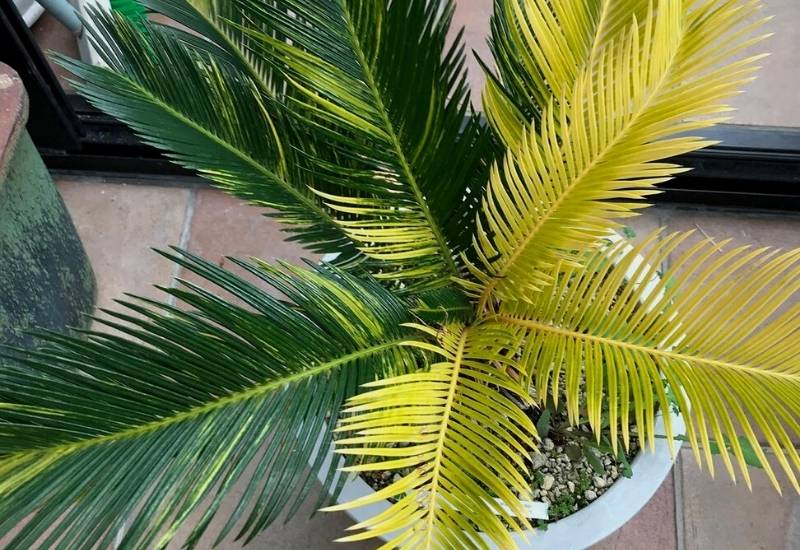
Sago palm is not a true representative of the palm tree family. Though it shares the name and appearance, sago palm is no palm at all. Instead, it is a member of the cycad family.
Nevertheless, people still call this plant a palm and use it as a reliable indoor container plant. It requires only a small amount of light and grows slowly to what remains a manageable size.
The reason for the mischaracterization of this species as a palm is that it shares a remarkable resemblance. The leaves are long and arching with a feathery shape and texture.
For best results, try to give your bonsai sago palm at least three hours of sunlight per day. Other than that, you need only to ensure adequate drainage in its soil.
7. Howea Forsteriana (Paradise Palm)
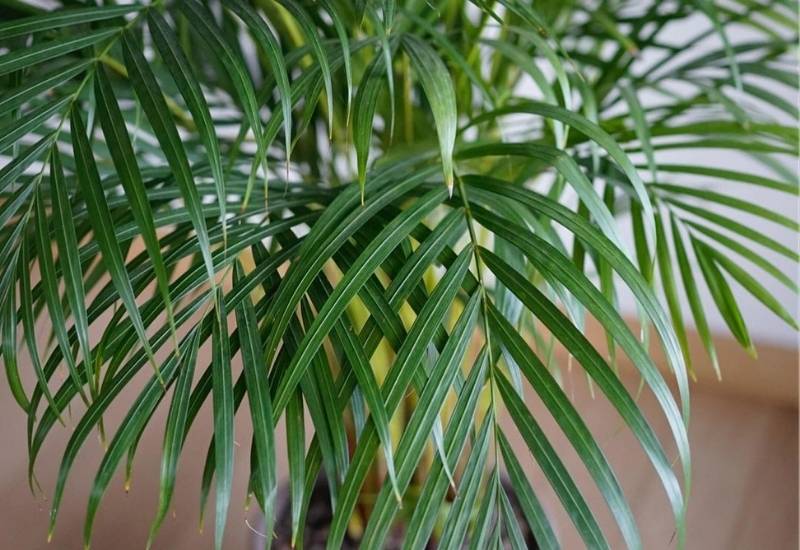
Although it eventually reaches 8 feet, the slow growth rate of paradise palm makes it a suitable indoor option. The ideal light exposure for this plant is also an advantage to indoor growers.
Paradise palm is among the minority of palms that do not have full sun as their preference. Filtered light is the paradise palm’s favorite, and the low light conditions of an indoor room will also suffice.
This palm has a wide appearance, and the mature spread often surpasses the mature height. Paradise palm has a narrow trunk holding long leaves as the main components of its form.
Those leaves can reach ten feet in length on their own. However, it is rare that a paradise palm will achieve such copious growth as a container plant.
8. Dypsis Lutescens (Bamboo Palm)
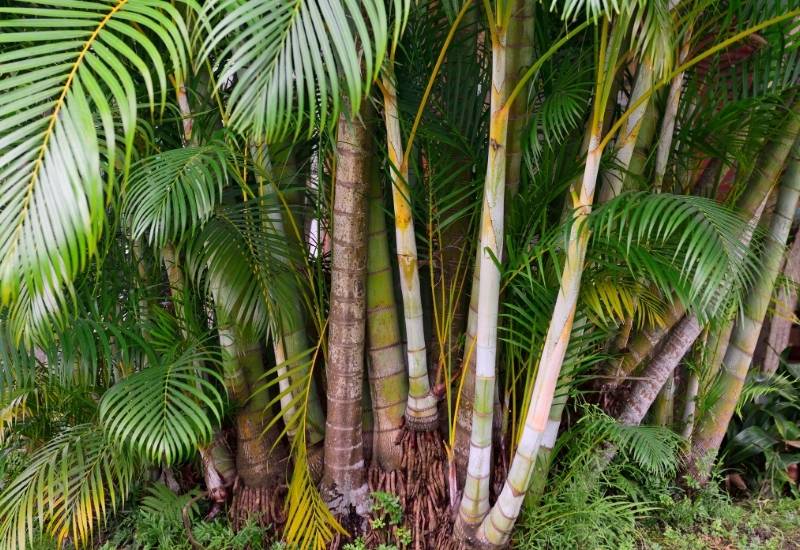
Anyone searching for a palm variety that will perform well indoors will surely come across this species. That’s because bamboo palm is one of the most commonly sold palms for indoor growing.
This palm gets its name from its growth habit. A multitude of stems emerge from the ground and comprise the majority of this plant’s size. These stems look a lot like the canes of a bamboo plant.
At the top of each stem is a series of long, waving leaflets. These can appear in sets of up to 60, and the leaf’s entire length can be multiple feet. This container plant is a great option for adding a lively appeal to your living spaces. Just be sure to provide acidic soil and a reasonable amount of light to encourage the best growth.
9. Beaucarnea Recurvata (Ponytail Palm)
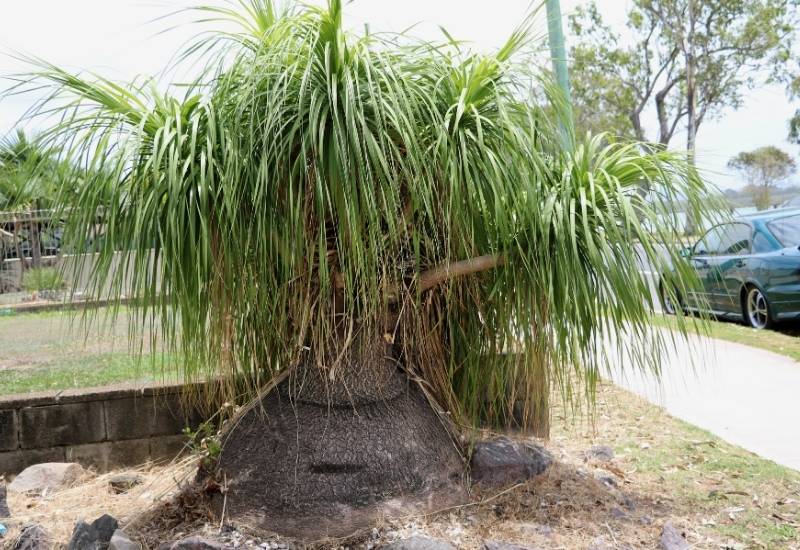
Ponytail palm is an aptly named plant that is more than a background fixture. The cascading foliage of this palm is sure to catch the eye of anyone who enters the room in your house where it grows.
Though it grows to be significantly larger in the wild, ponytail palm takes on a modest size when growing indoors. This palm also has an interesting trunk that bulges to retain water.
As with some other indoor “palms,” ponytail palm is not a true palm species. But that is no reason to neglect ponytail palm when choosing your next indoor container plant.
The most interesting feature of this plant, by far, is its leaves. Those leaves are long and thin. They fall in a curling manner on all sides of the plant, much like a head of long flowing hair.
10. Rhapis Excelsa (Lady Palm)
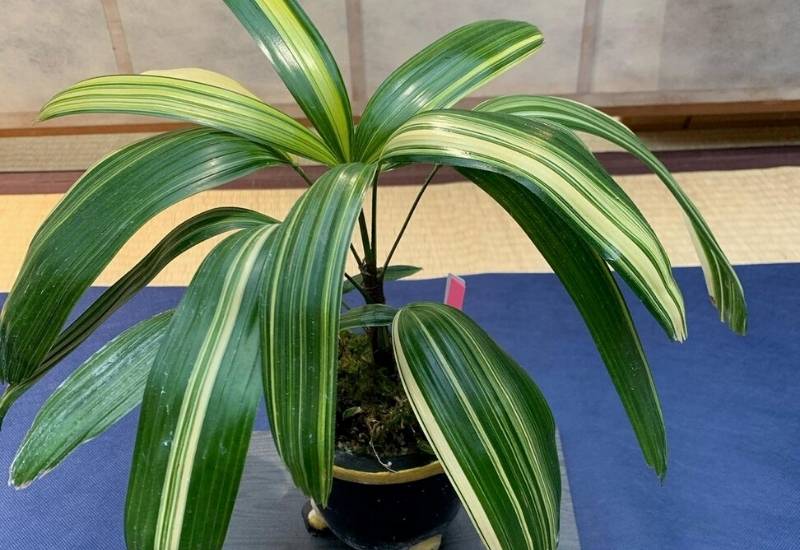
Native to Chine, lady palm is an impressive palm that grows well as an indoor container plant. It calls for limited light and offers attractive foliage.
The leaves are fan-shaped, and they have a deep lustrous green color. They grow from the end of stalks that are reminiscent of bamboo.
Among palms, lady palm has comparatively showy flowers. While not nearly as astounding as the flowers of other non-palm species, lady palm blooms form pleasing yellow clusters.
Lady palm tolerates high levels of humidity, making it an even stronger candidate for indoor use. It also has a very uptight form and a dark fibrous exterior texture.
Outdoor Palm Tree Varieties
Most people living in North America will only see palms growing in indoor settings or in greenhouses. The cold winters of much of the continent are too much for most palms to handle.
But there remain many palms that grow in the wild as well. These species often reach massive heights with groupings of long leaves sprouting from the top of a long slender trunk. It is this admirable form that has led to so many dwarf palm varieties for indoor use.
The native range of these palms just barely reaches the southernmost parts of the United States. So, if you live there, or visit there, be sure to check these palms out.
11. Roystonea Regia (Royal Palm)
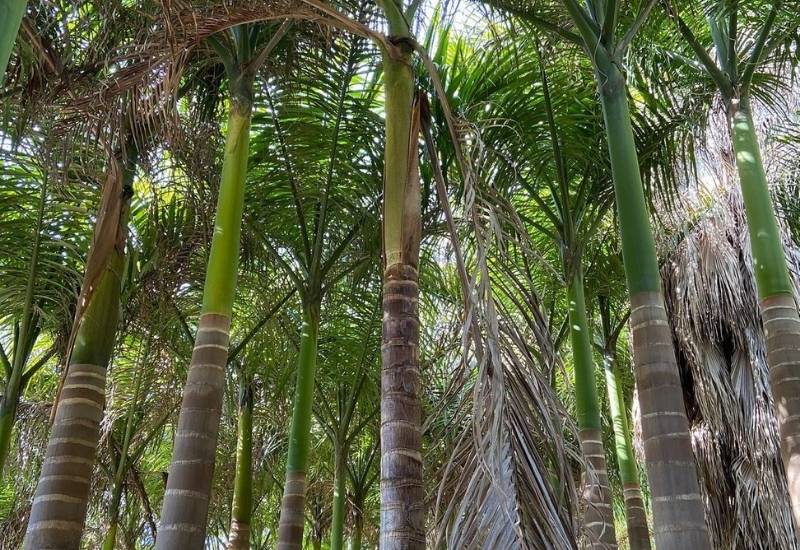
Despite sometimes having the name Florida royal palm or Cuban royal palm, this palm tree originates in Mexico. It grows commonly in the wild there and throughout hardiness zones 10 and 11.
Royal palm is a large palm tree that reaches about 100 feet. Its mature spread is often far less pronounced at only 20 feet.
In youth, this palm tree can tolerate some shade. However, full sun becomes a necessity as the royal palm reaches maturity.
This tree grows to develop a light grey trunk with minimal texture. From this trunk grow the massive feathery leaves of royal palm.
Royal palms often have just over ten leaves. But these leaves can be nearly 15 feet long, and each holds a multitude of leaflets.
12. Wodyetia Bifurcata (Foxtail Palm)
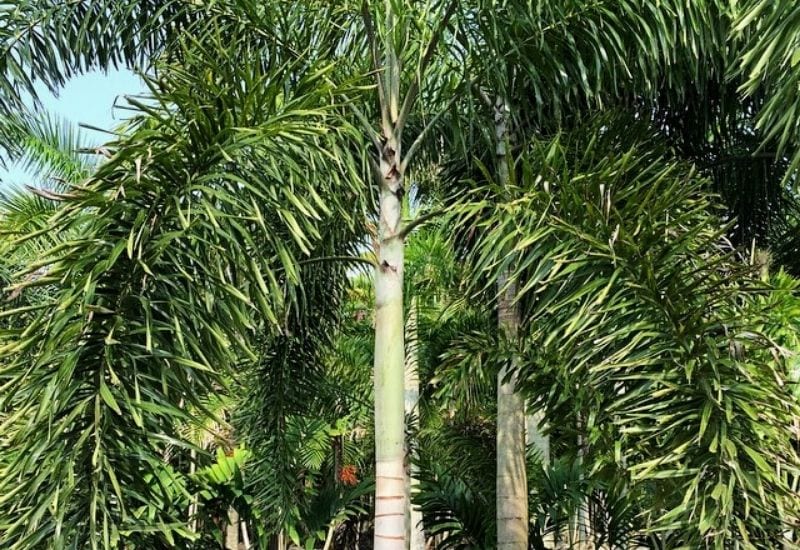
Foxtail palm is a palm tree native to the Australian outback. It now grows as a highly popular landscape plant throughout many of the most southern states in the U.S.
This palm tree shares a similar appearance to a royal palm, so it can be difficult to distinguish the two. However, one of the main differences is in size.
While royal palm grows to nearly 100 feet, foxtail palm can only reach half that height. But in most cases, it only grows to about 30 feet.
Foxtail palm has large sets of feathery leaves that resemble a massive fox’s tail. These leaves shimmer in the breeze adding to the impressive appearance of this palm tree.
13. Chamaerops Humilis (European Fan Palm)
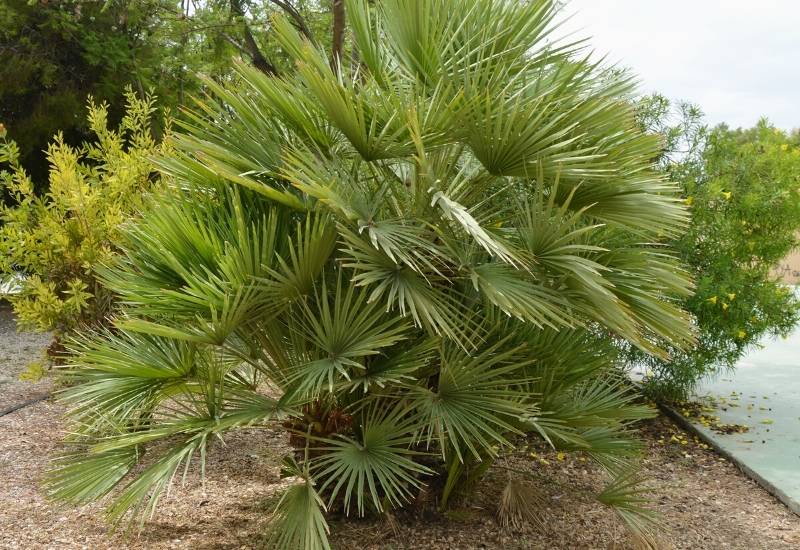
European fan palm grows as a large shrub or as a small tree that reaches about 15 feet. In most cases, this palm tree will have multiple trunks of equal size.
Each trunk takes on an increasingly textured appearance as it grows. If it is your preference, you can prevent the European fan palm from suckering, which will create a single-stemmed growth habit.
European fan palms have leaves that are both thin and wide. The many divisions on these leaves create a multitude of sharp points in the foliage.
You will find no other palm tree native to Europe beyond this species. But even then, the range of European fan palm rarely expands past the Mediterranean.
14. Washingtonia Robusta (Mexican Fan Palm)
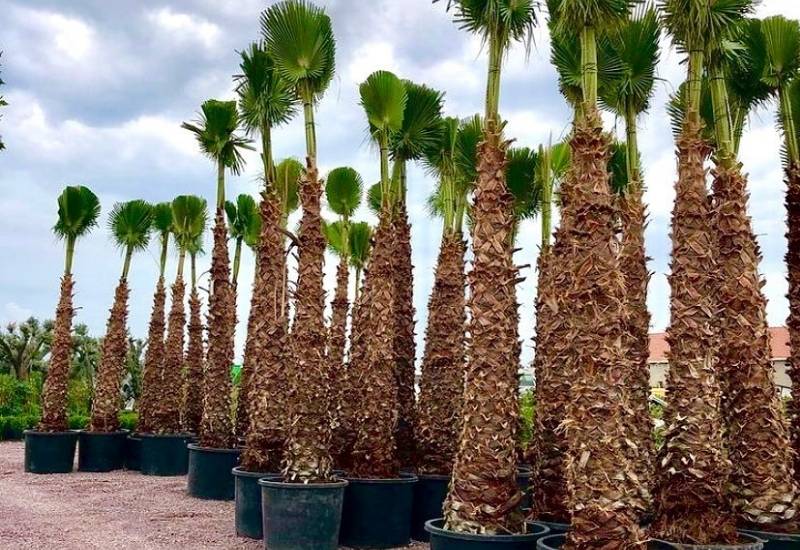
Mexican fan palm is a palm tree native to Mexico and parts of the American Southwest. This palm tree grows fast and has a long lifespan. These factors account for the impressive size of this palm.
Mexican fan palm is also highly adaptable. It can tolerate soils of any acidity level and any level of moisture.
Overall, this palm develops into a tall but exceptionally narrow tree. The mature spread may only be a tenth of the mature height.
The leaves of Mexican fan palm have been a useful material for the construction of many handmade items, including baskets. The tiny black fruits are edible, as well.
15. Livistona Chinensis (Chinese Fan Palm)
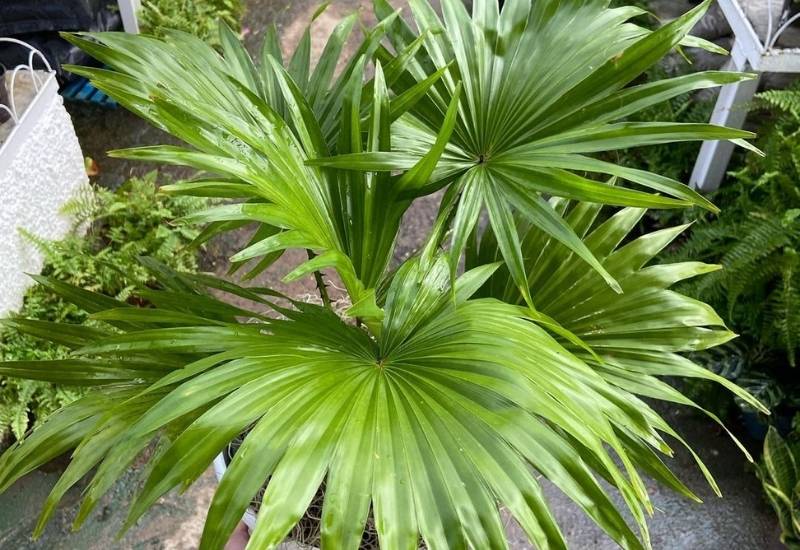
Although native to China, Chinese fan palm is one of the most common palm trees in the Florida landscape.
There, it is considered invasive but remains a popular ornamental tree. Unlike its dwarf cultivars, the true version of Chinese fan palm is a medium-sized tree. It often grows to about 30 feet.
Part of the reason for the rapid spread of Chinese fan palm is that this plant can tolerate dry soils. In fact, it prefers to have its soil dry out completely after a watering.
The textured leaves of Chinese fan palm can be massive. They have a broad fan shape that can span nearly 6 feet. At times, these leaves can have a drooping appearance.
16. Dypsis Decaryi (Triangle Palm)
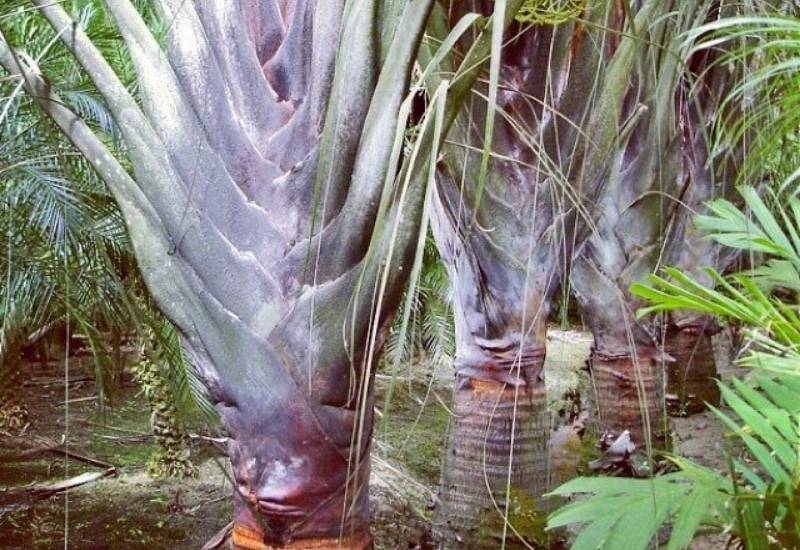
Triangle palm is a popular palm variety that has admirable drought tolerance. This resistance to drought is especially effective after this species has had time to establish itself.If you plant a triangle palm, you’ll find that it needs very little water and very little pruning as well.
This makes for a very low-maintenance palm that offers plenty of aesthetic appeal. Along with the minimal care requirements, people love triangle palm for its interesting appearance.
Its growth habit is the main attraction as this palm’s canopy is flat. It appears to be a nearly two-dimensional triangle shape.
Triangle palm is native to Madagascar. It grows to be a small to medium-sized tree. In its lifetime, you can expect it to have no pests or diseases as it grows in a wide range of soils.
17. Brahea Edulis (Guadalupe Palm)
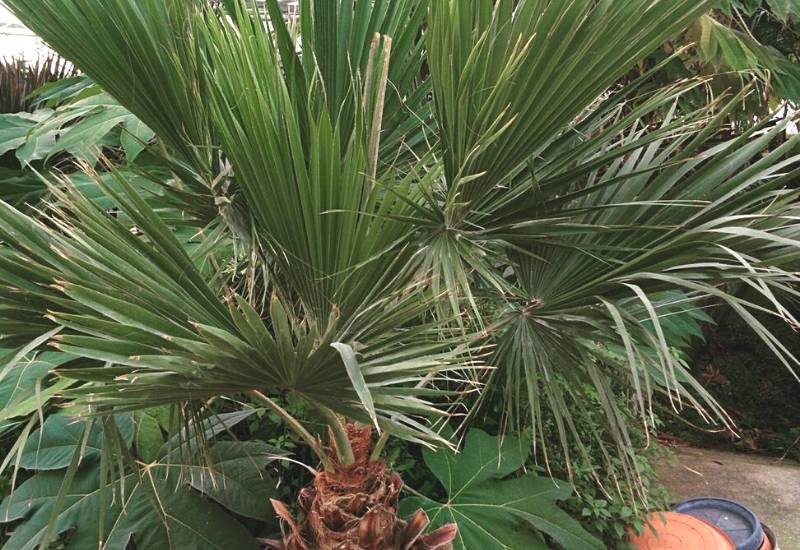
Guadalupe palm is a drought-tolerant palm that needs little to no form of irrigation. Especially after this plan has established itself, it will never need anything more than an occasional watering in the hottest months.
This palm variety has minimal other care requirements as well. This includes no pruning needs and no issues with pests or damaging diseases.
Guadalupe palm grows with a single stem and develops into a medium-sized tree rarely exceeding 30 feet. Its leaves are broad and have a fan shape.
This palm also has edible fruit. Following sets of fragrant flowers, the black fruits form and offer a soft sweet flesh.
18. Butia Capitata (Jelly Palm)
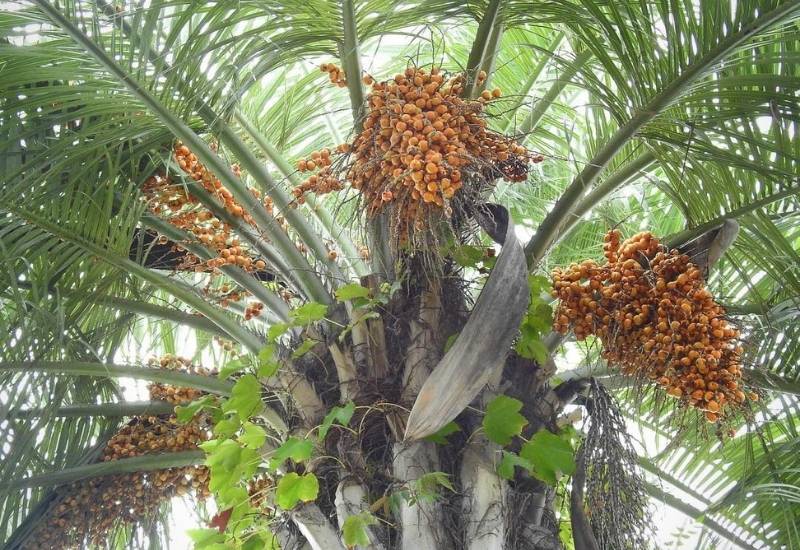
Given that jelly palm is native to warm regions of South America, it naturally prefers hot weather. But regardless of this preference, jelly palm can survive in temperatures as low as 20 degrees Fahrenheit.
Along with admirable cold hardiness, jelly palm is an extremely attractive species. It has an arching habit to its leaves and a textured trunk that shows where old leaves once grew.
Jelly palm also has lovely flowers that are fragrant, yellow, and nearly three feet long. These flowers lead to clusters of edible fruits.
This palm tree variety is also easy to care for. It has little to no known disease issues and can adapt to a wide range of soils and different levels of sun exposure.
19. Bismarckia Nobilis (Bismarck Palm)
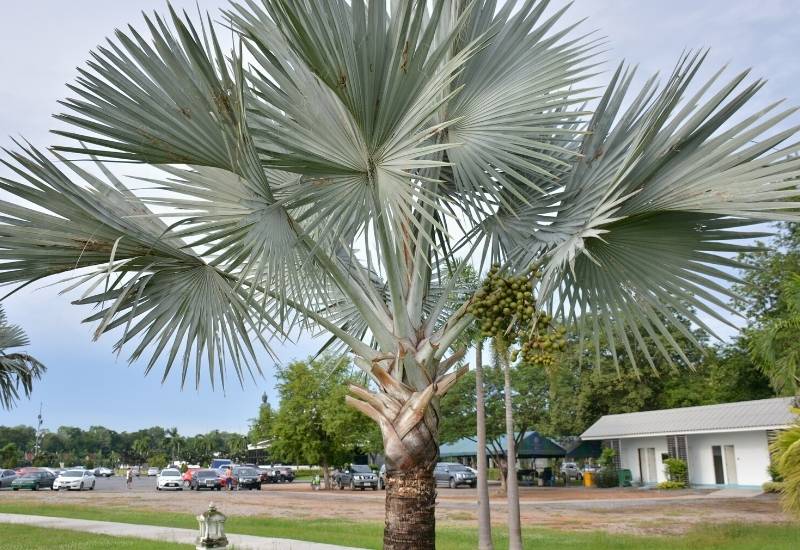
Bismarck palm is a medium to large palm tree that is surprisingly cold hardy. As with most palms, Bismarck palm enjoys warm climates. However, it can recover from occasional temperatures below freezing.
Bismarck palm has lovely fan-shaped leaves that hold an interesting color. Rather than being pure green, the leaves have a light bluish-green color.
The trunk of Bismarck palm is often thick and short. In youth, this trunk will grow very slowly. But as this palm species gets older, its growth rate tends to increase.
This palm variety is a relatively low-maintenance plant but can present some issues at times. Most notably, this palm tree can show damage when growing in settings with intense gusts of wind.
20. Phoenix Canariensis (Canary Island Date Palm)
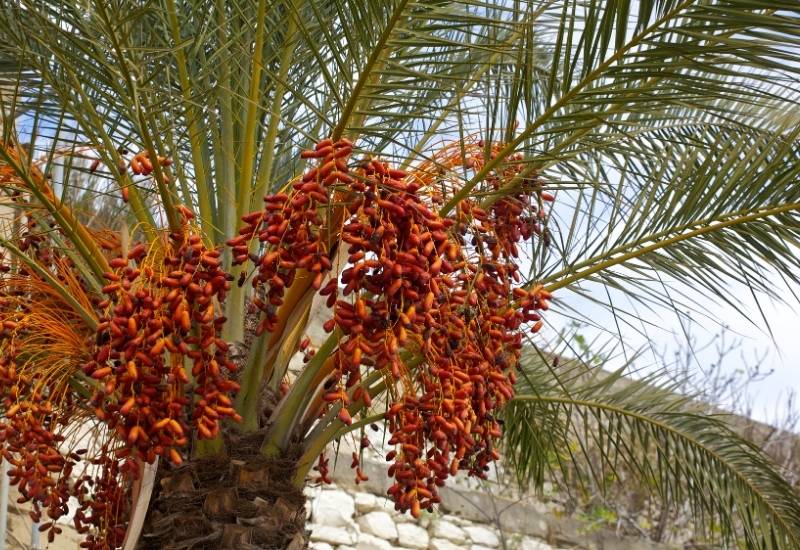
Based on the common name, it is no surprise to learn that Canary Island date palm is native to the Canary Islands. This palm species shares a genus with the standard date palm.Canary Island date palm is more cold hardy than many other palm tree varieties.
This palm can survive in regions with average lows around 20 degrees Fahrenheit. However, these cold temperatures can cause some damage to the leaves.
Each leaf on this palm carries countless leaflets along its nearly 15-foot length. These leaves appear in an arching form at the top of the Canary Island date palm’s thick trunk.
Canary Island date palm grows well near the sea and is relatively low maintenance. Outside of its natural setting, this palm can also grow as a container plant.
Palm Varieties With Fruit You Can Eat
Several palm tree varieties bear edible fruit that serves as a reliable food source. But what you may not realize is that many forms of produce featured in a standard grocery store come from palm trees.
Additionally, there are some palms that bear lesser know fruits as well. These lesser-known palm fruits are sometimes used for medicinal purposes or as key ingredients in the regional dishes of their respective native ranges.
Take a look at some of these varieties of palms with edible fruit.
21. Cocos Nucifera (Coconut Palm)
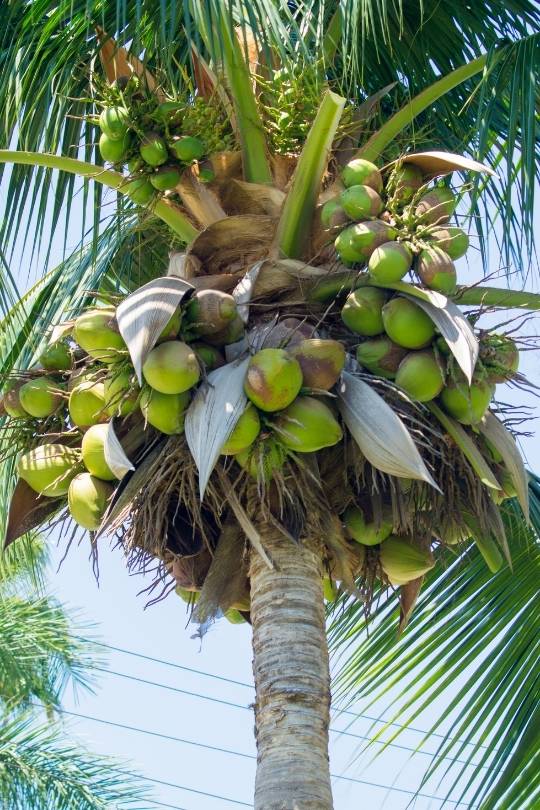
Many may be unaware that coconuts come from a variety of palm tree called the coconut palm tree. Although there are very few places in the United States where these palm trees can grow, their fruits are well known.
The fruit of a coconut tree can be over two feet long but only holds a single seed. A hard, fibrous exterior shell protects the seed and the fruit’s flesh.
Coconut palms need hot weather to thrive. When they don’t get the heat they need, these palm trees will fail to produce any fruit.
When in the proper setting, coconut palm trees can grow to be incredibly large, with a spread nearing 40 feet.
They also send forth large yellow flowers with a distinct aroma. However, you should be aware that in the few areas where this tree will grow in America, it is often listed as an invasive species.
22. Phoenix Dactylifera (Date Palm)
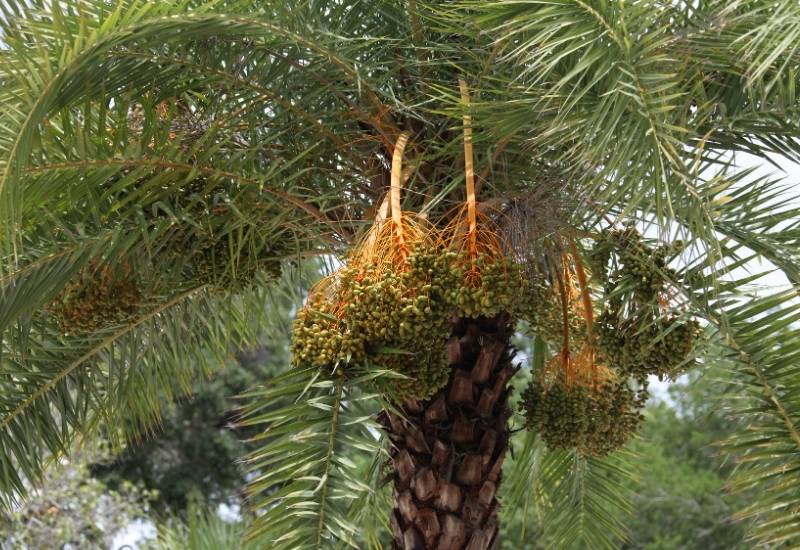
Date palm trees are a low maintenance palm tree variety that is native to the Middle East. When conditions are right, this palm tree will produce copious amounts of dates as its fruit.
These fruits first appear green then gradually change to a reddish-brown as they ripen. So long as conditions are right, date palm needs little to no care to produce its delicious fruits.
Date palms are slow-growing trees but will eventually reach about 80 feet in height with a spread about half that size. Much of that spread includes the hundreds of feathery leaves that comprise the canopy.
Date palm trees need full sun and soil that does not get too moist. When these conditions are met, date palm trees will thrive with no need for pruning.
23. Euterpe Oleracea (Acai Palm)
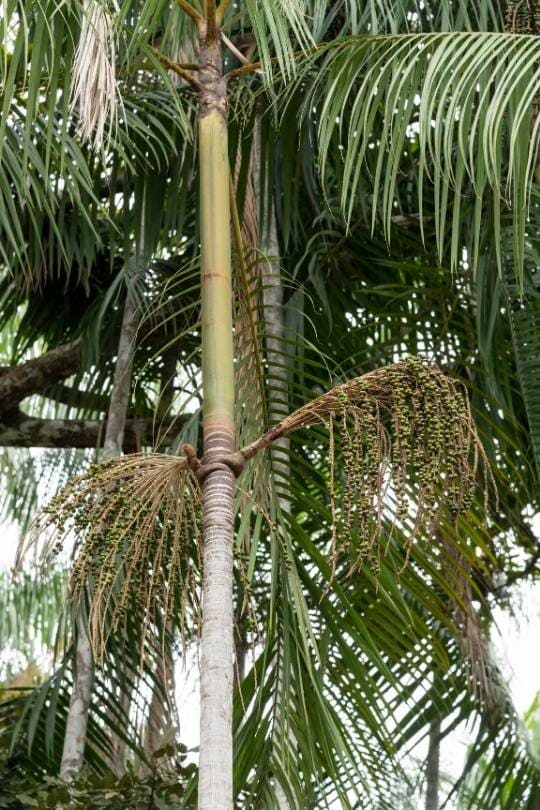
Acai palm is an understory tree that produces an edible berry as its fruit. As an understory plant, it prefers to grow in partial or full shade.
This palm tree is also rather narrow with a mature spread that is less than half the mature height. Despite this, the leaves are long and tend to grow with a very upright habit.
Acai palm grows best in acidic soils that remain moist. Once established in that kind of soil, it will take several years for this palm tree to produce its valuable fruit.
In some regions of the world, acai berries are a highly sought-after food. Many believe that these fruits have medicinal qualities. Health aside, these berries prove to be very flavorful.
24. Bactris Gasipaes (Peach Palm)
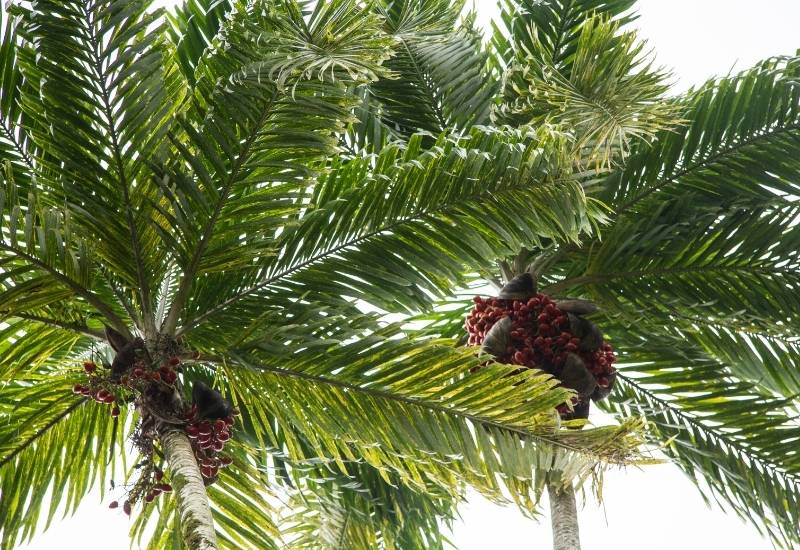
Peach palm is a large palm tree with a relatively large fruit. This fruit is not technically a peach, but it does bear some resemblance, especially on the inside. However, this fruit is not the most commonly eaten part of this tree.
The fruit is edible, but it requires a long preparation process before a person can eat it safely. But the heart of this palm is ready to eat right away.
Peach palm grows in rainy areas of south and central America. There it enjoys wet soils and full sun exposure.
This palm lives for many years and offers fruits for the majority of its lifespan. In its native range, people there use the fruit as food for themselves and for their livestock.
25. Elaeis Guineensis (Oil Palm)
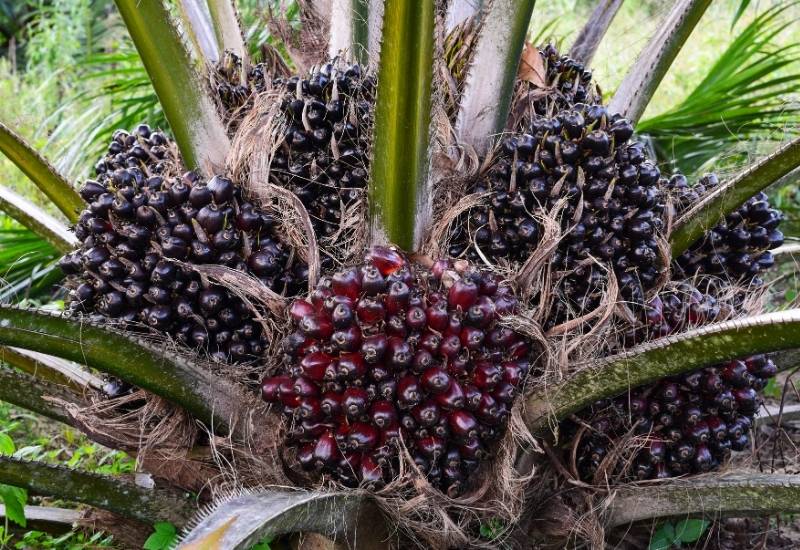
Oil palm grows in vast quantities throughout Africa. It is known to produce countless oil-based products that have since made this tree valuable throughout the world.
The oil palm name comes from the fact that one of the main uses for this palm is as a cooking oil. But this palm also helps in the creation of soaps and cosmetics.
Oil palm has large red to orange fruits that hang from the tree. The seeds of this fruit are one of the main sources of the highly coveted palm oil.
Overall this is a relatively large tree that reaches nearly 50 with a spread of about half that size. It requires moist soils and full sun, such as its subtropical home provides.
Conclusion
Palms are one of the most recognizable plants in hotter climates. These plants come in countless varieties and offer value in a multitude of distinct ways. Some carry intriguing textured foliage.
Others are known for delicious fruits. As long as you live in a warm environment or set up an indoor area, you can enjoy palms as a part of your garden. Hopefully, this list will help you identify and choose a suitable palm tree variety.

Written By
John Haryasz
John Haryasz is a writer with a background in landscape architecture. His education includes a Bachelor of Science in landscape architecture from UMass, Amherst with a minor in psychology. Following graduation, John worked in a small landscape architecture office. In this role, he led many successful projects in Berkshire County, MA. After a few years, John began offering freelance design services. He has since produced designs for projects across the country. As a writer, John aims to share knowledge while promoting engagement with the outdoor world.

Hey John, so do the canary date palm trees produce dates, or is there a way for it not to produce fruit?
JR
How do I get hold of various palm seeds